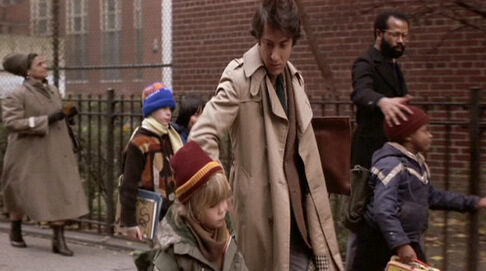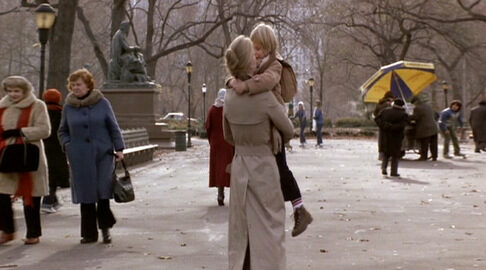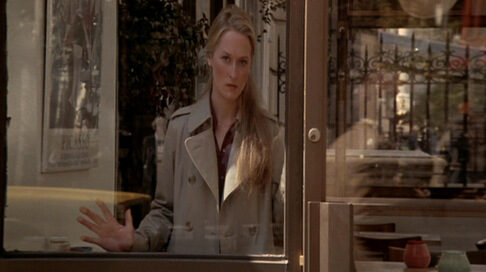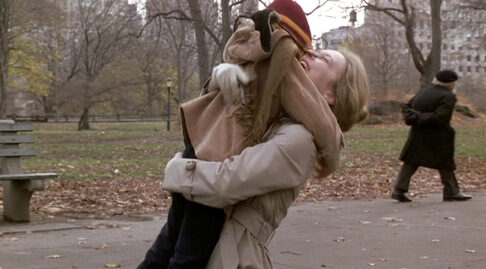Kramer vs. Kramer: Meryl Streep in a Burberry Trench Coat |
 © 2013, Clothes on Film 21 Mar ’13
© 2013, Clothes on Film 21 Mar ’13
Kramer vs. Kramer (1979) is costume symbolic of its era; the entire film is filtered through a composite mix of tan and beige. Director Robert Benton opted for a permanent autumn in New York City, artistically maintained through its year long storyline. Autumn is interpretable as a transitional season, reflecting the three act journey of the three central characters. Costume designer Ruth Morley dresses Meryl Streep’s absentee mother Joanna head-to-toe in various shades of brown. Joanna’s appearance is regimented by control and routine, and nearly always finished by that epitome of late 1970s chic and impending yuppiedom, a three quarter length Burberry trench coat.
Confirmation of the Burberry trench functioning with greater purpose than a means to keep dry occurs at the beginning of the film, not via Joanna but her childish and neglectful husband Ted (Dustin Hoffman). Ted recounts a self-indulgent anecdote to his boss: in order to wear success “you need to get yourself a Burberry trench coat” – he continues this story right up to moment he commits to buy. This is significant as later in the movie Ted is wearing a trench coat which we may reasonably conclude he purchased as part of his anecdote, yet it is not made by Burberry.


Streep’s coat is definitely a Burberry, but judging by the lining of Hoffman’s, specifically the tighter plaid and darker colourisation, it is actually an Aquascutum. Although Burberry is the best known manufacturer of the trench coat they did not invent the design, having based their version on a Tielocken, which was first seen during the Second Anglo-Boer War (circa 1899). Burberry patented their waterproof fabric gabardine and were commissioned to produce coats for the First World War (where they picked up the ‘trench’ moniker). Aquascutum also claim to have invented the trench coat, indeed their own waterproof fabric was worn by British officers during the Crimean War (1853-1856). Nonetheless the coat’s classic features, the throat latch and epaulettes for example, were introduced by Burberry. Both names were – and still are – desirable brands for trench coats.
Joanna holds her trench coat when she leaves Ted and son Billy (Justin Henry) and then wears it when she returns to them later in the film. We are afforded a brief glimpse of her wardrobe, literally, as she hurriedly packs a suitcase. Joanna folds her clothes quickly but neatly; a seemingly drab collection of neutral skirts and blouses, including one tiny, blue and very dirty sweater belonging to Billy. Garments are more powerfully emotive than photographs as they necessitate touch and scent to evoke memories; while Joanna is not externally emotional, she is a deep thinker. Retaining the sweater means that she never truly lets go of her son.


Kramer vs. Kramer is not especially even handed. The story is complex enough to engage both sides of the custody argument, yet Joanna is portrayed visually as something of a femme fatale. Her appearance is controlled and immaculate. The femme fatale never accidently wears anything; she understands exactly what clothes say and chooses them carefully to stir feelings in those around her. Typically for the femme fatale these are sexual, powered by fear or jealousy to provoke the male into action. Here the intention is different; Joanna is presented as a predatory almost spectral figure. She lingers, watches, and when the moment is right, she strikes. The coat is her iconography. It marks Joanna out as the closest Kramer vs. Kramer has to a villain.
Joanna is reminiscent of Norman Bates as the camera jump cuts to her standing behind a coffee shop window, hands pressed up against the glass, glaring as Ted takes Billy to school. Ted is the complete opposite of Joanna’s regimented persona, which ironically is indicative of her own existence spiralling out of control; her perfectly co-ordinated separates and permanent trenchcoat are a control mechanism, like a frantic exercise regimen or eating disorder. Conversely Ted’s life (i.e. career) is progressing well. He believes his home life is too of course, but tellingly away from the office he acts like a slob. He stops trying.


Sporadically Ted does wear a 3 piece suit for work, but it is his disguise rather than uniform. Ted is never as career successful as Joanna turns out to be, even considering his promotion at the start of the film (which prompts the 3 piece suits). Although as it transpires, or at least the story we are told, Joanna is not as successful a parent. Their roles are ill-fitting yet decreed by centuries of gender stereotyping. While Kramer vs. Kramer does not play fair in its dissection of changing attitudes to women in the workplace it does predate Working Girl (1988) as pro-change, if not legitimately pro-feminist.
Hints of colour creep into Joanna’s clothes during the last act. Second day in court she wears a hint of cornflower blue; fresh and moving away from matronly (if stylish) browns, Joanna is seen as the safe choice. She is brand new, while Ted, still more comfortable in short sleeve shirts than the restrictive mesh of suit and trench coat, has merely stepped up to the plate. In figurative terms he donned the suit and necktie and got the job done, a job he should have been doing in the first place.


Eventually the estranged couple meet in middle. For their penultimate scene outside the court room when Joanna pleads forgiveness from Ted, she is not wearing her trench coat. Subtext implies that her ethereal femme fatale has transformed into more than a symbol, realised she gone too far insinuating Ted is a neglectful father and stepped back from the brink. She accepts his capacity to change as well as her own. On a more practical level, Streep was pregnant at the time of shooting so wearing a looser unbuttoned coat hid her blooming figure.
However Joanna’s cotton-weave Burberry trench endures as the most contemporary update of the classic noir silhouette. The emasculated man, typically victim of the femme fatale, has now passed his gumshoe uniform onto her. Yet Joanna is unusual in that she manipulates herself through clothes rather than others. Once trapped by a desperate need to control just this one element of her life, Joanna has evolved her expectations, and if the last shot of the film is anything to go by, her wardrobe too.
© 2013, Chris Laverty.